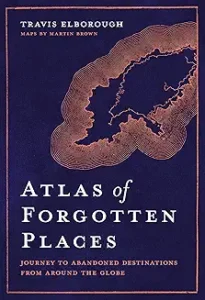Atlas of Forgotten Places: Journey to Abandoned Destinations From Around the Globe by Travis Elborough 2021
I can’t recall how I came across this book, but I’m glad I did. It’s one of those weird, strange, ‘huh’ books that I love—a hidden treasure of information and quirky views of the world.
In the introduction, Elborough, a 53 year old British essayist and critic, explores the terms “forgetting”, “slipping our mind”, “misplaced”, “lost”, and “abandoned” and applies the latter to “places eventually rendered surplus to requirement by the most subtle shifts in patronage, trade, politics, health care, social custom and climate….The mapping of the relinquished in the light of such recent events has never seemed more urgent or relevant. Their stories can teach us important lessons about impermanence, consumption, booms and busts, industrialization and the environment, the hubris of mankind and the unreliability of memory and memorialization.”
This book follows his “Atlas of Improbable Places” which I must find now based on the fascinating stories in this volume. Elborough provides historical background, current information, photos, country maps, and site maps for 40 places around the world that have been abandoned, misplaced, and neglected. The ruins of palaces, schools, hospitals, subway stations, churches, prisons, airports and train stations, hotels, malls, and entire towns provide him with a reason to “think longer and harder about the world to come, and what might be worth salvaging from the wreckage.”
From an island off of Turkey to a mountain top in Haiti, from an abandoned mining towns in Sweden and Alaska to a mall in Thailand whose flooded buildings were stocked with fish, these are fascinating stories of man’s follies and the fickle finger of time and fate. What elevates these stories from the interesting to the fascinating is the author’s ability to provide enough detail about the people and the times which led to the original projects. In one example, we learn about a British soldier and politician named Edward Coke who in 1849 asked the hatters at Lock & Co. of St. James Street to make him some protective headgear for his gamekeepers whose traditional hats were being knocked off and damaged by the low hanging branches and limbs of the trees and bushes on his country estate. Lock & Co. outsourced the job to their chief manufacturers, Thomas and William Bowler, and voila, the bowler hat was created. Fast forward to the late 19th C when England was building a railroad in Bolivia to move salt, silver, sodium nitrate, sulphur, borax and other valuable natural materials from La Paz to the coast. An enterprising entrepreneur in Manchester who had an overstock of bowlers in small sizes shipped them to Bolivia and the Aymara Indian women today still wear bowlers as part of their traditional dress.
Stories like that one fill these pages. If you love maps, quirky stories, and photos of old ruins, this is the book for you. You can read all the interesting details, or just browse the fascinating photographs and maps. Great fun.



